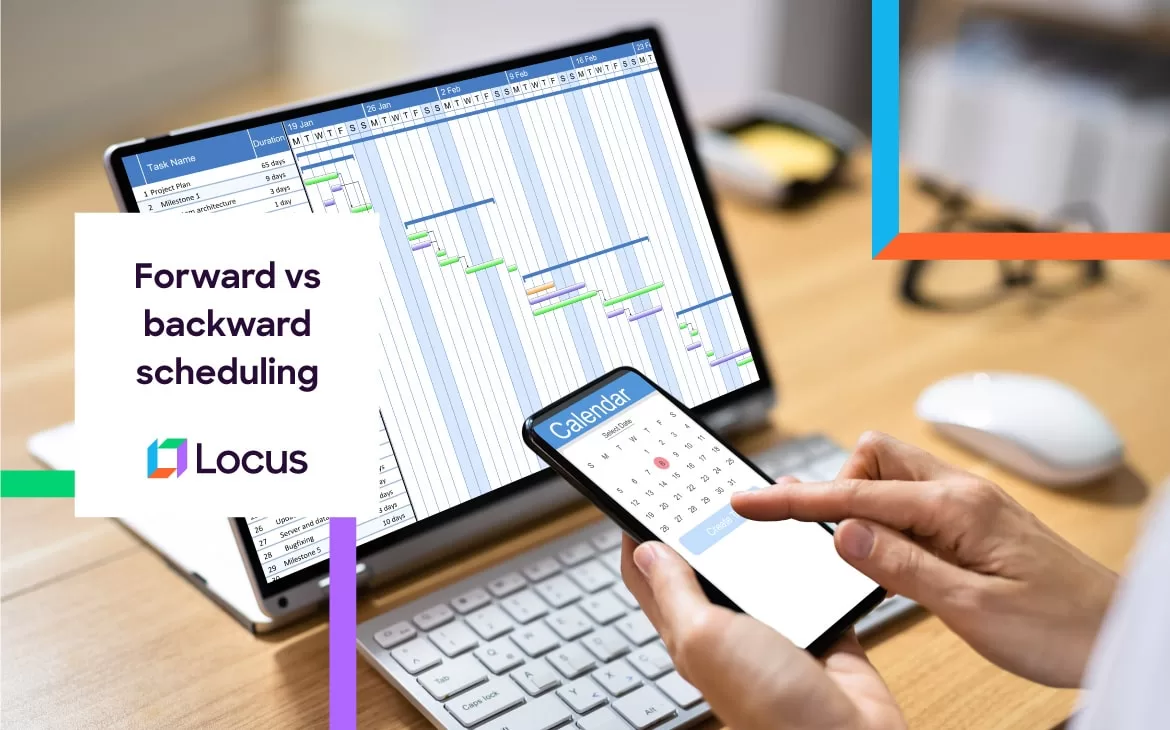General
Forward Vs. Backward Scheduling: What’s the Right Choice for You and Your Customers?
Jan 2, 2023
7 mins read

Imagine your customer purchased a refrigerator and scheduled a two-hour window out of her busy schedule for its installation. And just before their arrival, the field agent sends her a message saying they will be delayed. Frustrated, she leaves for the office with nothing but a “Sorry we missed you” message.
Such experiences are a make-or-break moment for a business. If not handled properly, it could snowball into a loss of trust and business through word-of-mouth, especially in today’s age of social media.
How can you avoid missed deadlines, and stay on top of the schedule? There are two proven strategies to be on time whether you schedule appointments or deliveries: forward and backward scheduling.
What is forward scheduling?
Forward scheduling allows businesses to plan and make deliveries at the earliest time by allocating tasks when the required resources are available, and completing them as quickly as possible.
While scheduling tasks forward, you line them according to the start date and then let it flow for the subsequent days. Overall, it’s a process that prioritizes making deliveries quicker and convenient.

Let’s say that you are a manufacturer. Your customer places an order for an item with a delivery date that is seven days away and the lead time for production is four days. As soon as you receive the manufacturing order, you start the production process and have it ready three days before it is due. Here, you use the resources as early as possible and hold the products in inventory until you can dispatch them.
What is backward scheduling?
Backward scheduling is another planning strategy where orders are scheduled based on customer-preferred delivery dates and times. This strategy is also called Just-In-Time (JIT) manufacturing. When your customer places an order with a specific deadline, your team should ensure that it is fulfilled to meet that deadline by planning backwards from the delivery date.
Backward scheduling answers a crucial question, “When should a business start its production at the latest, so that it fulfills the order on time?” Businesses work backward by allocating resources to the order and then determining the latest possible time to start manufacturing.

We will use the same example. Your customer places an order with a delivery date that is seven days away, and the lead time is four days. Then to meet the demands of backward scheduling, you start manufacturing latest by the third day.
When to choose forward and backward scheduling for your business?

In today’s age of ten-minute deliveries, even minor delays can prove destructive for your business. So, it is necessary to fulfill orders on time. The on-time order fulfillment rate of your business depends on the scheduling strategy that you use.
To make a huge difference in your order fulfillment and improve profitability, it is important to know when you should choose backward or forward scheduling. Let’s find it out now!
- Ease of planning
With forward scheduling, it becomes easier to plan delivery schedules or appointments than for backward scheduling. You should start with the orders you received first and keep working on the successive ones.
For backward scheduling, it is difficult to plan schedules because you have to work backward from the due date. And this requires you to invest in route optimization software for effectively planning tasks.
- Flexible delivery time
Do you want to satisfy your customers’ despite last-minute challenges? If the answer is yes, you should prefer forward scheduling as it begins the production process at the earliest, leaving ample room for accommodating any delays. Forward scheduling provides the flexibility to provide delivery time windows, so that you can accommodate the last-minute changes and satisfy your customers.
In backward scheduling, it is difficult to prioritize your workloads and make customizations to your product before delivering it as the JIT model works on the minimum possible lead time needed to ship a product, leaving no room for contingencies.
- Optimal utilization of workforce
When you want to make the best use of the existing workforce, forward scheduling is your go-to-plan for order fulfillment. You can reassign idle workers and reduce their downtime with forward scheduling tasks.
Also, you can quickly assign workers from forward-schedule jobs to highly urgent projects if necessary. As these workers are not permanently fixed to these jobs, there is more flexibility to schedule them. If optimal utilization of the workforce is your primary goal, then forward scheduling is the best option.
- Lower inventory costs
The biggest advantage of using backward scheduling is lower inventory costs. With backward scheduling, businesses fulfill orders using Just-in-time and this results in lower inventory costs, given that costs around storage and handling are kept to a minimum.
In forward scheduling, you may incur higher inventory costs as businesses complete their manufacturing too far before the due date, which increases costs around storage and handling.
- Assigning additional tasks
If you want your laborers to earn more by accommodating additional tasks, then forward scheduling works best for you. This helps you to prioritize the ad-hoc projects for less-important forward-schedule jobs without impacting the promised finish dates.
- Save materials and operational costs
By using backward scheduling, materials are used only when needed and this saves materials for your business. It helps you produce goods at the last moment before the due date, thereby saving operational costs. In forward scheduling, you wait for materials and resources to free up, resulting in failure to meet deadlines on time.
- Lead time issues
In forward scheduling, you may not be able to speed up the workflows when new orders come in as you have scheduled productions to your capacity. There will be no extra available resources to focus on that particular job, resulting in a longer lead time. If your product manufacturing is likely to have higher lead times, it is better to go with backward scheduling.
What’s the right choice for your business?: Forward or backward scheduling?
There is no straight answer on whether forward or backward scheduling is the right choice for your business as both of them have their share of advantages and disadvantages. Companies benefit from both these scheduling options, and can choose according to their business priorities. Key factors influencing your decision include how you manage your delivery services, customer demand, and business goals.
The best way to select the right scheduling practice among these two is by investing in delivery management software. It helps you find accurate scheduling practices based on your business constraints.
Locus’ delivery management software: The all-in-one tool for your backward and forward scheduling needs
Delivery management software enables you to smartly perform forward and backward scheduling – whether you are a manufacturer delivering orders to warehouses, or operations manager taking care of dispatch and appointments.
The Locus delivery management software is one of the best tools to manage your scheduling complexities as it takes into account real-world business constraints, its advanced algorithms ensure that scheduling is accurate, optimal and cost-efficient so that you can avoid missing critical deadlines. It helps you plan routes, track fleets and manage workload distribution, helping you stay ahead of the deadlines with adjustments in real time, be it for making deliveries, scheduling returns, and even rescheduling failed first attempts.
Want to stay ahead of deadlines with optimal scheduling suggestions?
Related Tags:

Retail & CPG
How Retailers in the US Can Step Up Their Delivery Game
Modern customers now want faster and customized delivery experiences, and logistics technology is revolutionizing the way retailers do business in the US.
Read more
Workforce Empowerment
Attract Truck Drivers by Improving Payout Visibility in the Last Mile
One of the biggest consistent challenges in last-mile delivery has been attracting and retaining truck drivers and it can be resolved by improving payout visibility.
Read moreMOST POPULAR
EDITOR’S PICKS
SUBSCRIBE TO OUR NEWSLETTER
Stay up to date with the latest marketing, sales, and service tips and news


Forward Vs. Backward Scheduling: What’s the Right Choice for You and Your Customers?